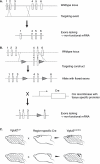Genetic inactivation of the vesicular glutamate transporter 2 (VGLUT2) in the mouse: what have we learnt about functional glutamatergic neurotransmission?
- PMID: 20187846
- PMCID: PMC2853350
- DOI: 10.3109/03009730903572073
Genetic inactivation of the vesicular glutamate transporter 2 (VGLUT2) in the mouse: what have we learnt about functional glutamatergic neurotransmission?
Abstract
During the past decade, three proteins that possess the capability of packaging glutamate into presynaptic vesicles have been identified and characterized. These three vesicular glutamate transporters, VGLUT1-3, are encoded by solute carrier genes Slc17a6-8. VGLUT1 (Slc17a7) and VGLUT2 (Slc17a6) are expressed in glutamatergic neurons, while VGLUT3 (Slc17a8) is expressed in neurons classically defined by their use of another transmitter, such as acetylcholine and serotonin. As glutamate is both a ubiquitous amino acid and the most abundant neurotransmitter in the adult central nervous system, the discovery of the VGLUTs made it possible for the first time to identify and specifically target glutamatergic neurons. By molecular cloning techniques, different VGLUT isoforms have been genetically targeted in mice, creating models with alterations in their glutamatergic signalling. Glutamate signalling is essential for life, and its excitatory function is involved in almost every neuronal circuit. The importance of glutamatergic signalling was very obvious when studying full knockout models of both VGLUT1 and VGLUT2, none of which were compatible with normal life. While VGLUT1 full knockout mice die after weaning, VGLUT2 full knockout mice die immediately after birth. Many neurological diseases have been associated with altered glutamatergic signalling in different brain regions, which is why conditional knockout mice with abolished VGLUT-mediated signalling only in specific circuits may prove helpful in understanding molecular mechanisms behind such pathologies. We review the recent studies in which mouse genetics have been used to characterize the functional role of VGLUT2 in the central nervous system.
Figures


Similar articles
-
Cellular localization of three vesicular glutamate transporter mRNAs and proteins in rat spinal cord and dorsal root ganglia.Synapse. 2003 Nov;50(2):117-29. doi: 10.1002/syn.10249. Synapse. 2003. PMID: 12923814
-
Synaptic and vesicular co-localization of the glutamate transporters VGLUT1 and VGLUT2 in the mouse hippocampus.J Neurochem. 2006 Nov;99(3):1011-8. doi: 10.1111/j.1471-4159.2006.04144.x. Epub 2006 Aug 29. J Neurochem. 2006. PMID: 16942593
-
Expression of the mRNAs encoding for the vesicular glutamate transporters 1 and 2 in the rat thalamus.J Comp Neurol. 2007 Apr 10;501(5):703-15. doi: 10.1002/cne.21265. J Comp Neurol. 2007. PMID: 17299752
-
VGLUT1 and VGLUT2 mRNA expression in the primate auditory pathway.Hear Res. 2011 Apr;274(1-2):129-41. doi: 10.1016/j.heares.2010.11.001. Epub 2010 Nov 24. Hear Res. 2011. PMID: 21111036 Free PMC article. Review.
-
VGLUTs define subsets of excitatory neurons and suggest novel roles for glutamate.Trends Neurosci. 2004 Feb;27(2):98-103. doi: 10.1016/j.tins.2003.11.005. Trends Neurosci. 2004. PMID: 15102489 Review.
Cited by
-
A method for the three-dimensional reconstruction of Neurobiotin™-filled neurons and the location of their synaptic inputs.Front Neural Circuits. 2013 Oct 1;7:153. doi: 10.3389/fncir.2013.00153. eCollection 2013. Front Neural Circuits. 2013. PMID: 24101895 Free PMC article.
-
Noise overexposure alters long-term somatosensory-auditory processing in the dorsal cochlear nucleus--possible basis for tinnitus-related hyperactivity?J Neurosci. 2012 Feb 1;32(5):1660-71. doi: 10.1523/JNEUROSCI.4608-11.2012. J Neurosci. 2012. PMID: 22302808 Free PMC article.
-
A hierarchical Bayesian mixture model for inferring the expression state of genes in transcriptomes.Proc Natl Acad Sci U S A. 2020 Aug 11;117(32):19339-19346. doi: 10.1073/pnas.1919748117. Epub 2020 Jul 24. Proc Natl Acad Sci U S A. 2020. PMID: 32709743 Free PMC article.
-
Dopamine and Acetylcholine, a Circuit Point of View in Parkinson's Disease.Front Neural Circuits. 2017 Dec 22;11:110. doi: 10.3389/fncir.2017.00110. eCollection 2017. Front Neural Circuits. 2017. PMID: 29311846 Free PMC article. Review.
-
Dorsoventral Arrangement of Lateral Hypothalamus Populations in the Mouse Hypothalamus: a Prosomeric Genoarchitectonic Analysis.Mol Neurobiol. 2023 Feb;60(2):687-731. doi: 10.1007/s12035-022-03043-7. Epub 2022 Nov 11. Mol Neurobiol. 2023. PMID: 36357614 Free PMC article.
References
-
- Fonnum F. Glutamate: a neurotransmitter in mammalian brain. J Neurochem. 1984;42:1–11. - PubMed
-
- Moriyama Y, Yamamoto A. Glutamatergic chemical transmission: look! Here, there, and anywhere. J Biochem. 2004;135:155–63. - PubMed
-
- Chen J, Lipska BK, Weinberger DR. Genetic mouse models of schizophrenia: from hypothesis-based to susceptibility gene-based models. Biol Psychiatry. 2006;59:1180–8. - PubMed
-
- Nestler EJ, Barrot M, DiLeone RJ, Eisch AJ, Gold SJ, Monteggia LM. Neurobiology of depression. Neuron. 2002;34:13–25. - PubMed
-
- Kashani A, Lepicard E, Poirel O, Videau C, David JP, Fallet-Bianco C, et al. Loss of VGLUT1 and VGLUT2 in the prefrontal cortex is correlated with cognitive decline in Alzheimer disease. Neurobiol Aging. 2008;29:1619–30. - PubMed
Publication types
MeSH terms
Substances
LinkOut - more resources
Full Text Sources
Research Materials
Miscellaneous
